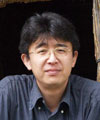Cutting-Edge Research
in Kyoto University
SILVICULT
Learning from Old Japanese Ways Towards the future, with the blessings of the forest.

Japan is a forest country. 67% of the land is covered with forests, of which 40% is plantations. Although, in the past, the Japanese developed customary practices for the sustainable use of forest resources, their traditional knowledge of “site-adapted forestry” is being lost due to social and economic changes in recent decades. I am developing a new sustainable forest utilization system suitable for modern and future societies which combines traditional methods and forefront technologies, such as Global Navigation Satellite Systems (GNSS), remote sensing, and forestry machines. This approach is called “precision forestry,” and it involves not only forestry, but also the fields of ecology, engineering, economics, and sociology. While engaged in this challenging multidisciplinary work, I am living in a community near the Wakayama Forest Research Station, where I work in collaboration with the local community.

- Hisashi Hasegawa, PhD
- Chief and Associate Professor,
Wakayama Forest Research Station, FSERC
